

UK Digital Strategy. 2017 nmc horizon report he EN. Education and Training Monitor. The Education and Training Monitor is an annual publication that captures the evolution of education and training in the EU.
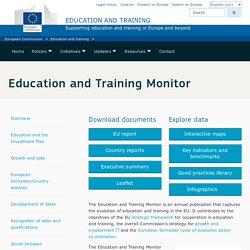
It contributes to the objectives of the EU strategic framework for cooperation in education and training, the overall Commission's strategy for growth and employment and the European Semester cycle of economic policy co-ordination. The Education and Training Monitor relies on a broad range of quantitative and qualitative sources, including Eurostat data, OECD studies and surveys, analysis of education systems undertaken by the Eurydice network, quantitative analysis of survey datasets, and academic networks. The Monitor charts EU and country progress towards: With its international comparison and country analysis, the Monitor fuels the debate on priority themes for education and training, informs national education reform debates, and stands as a reliable and up to date source of information for peer learning among EU Member States.
Education at a Glance. Mary Meeker's 2016 internet trends report: All the slides, plus analysis - Recode. Compendium of case studies about Open Education in the Mediterranean: now online! – OpenMed. Professors in doubt over value of distance education. MOOCs Expectations and Reality. Study: Digital textbook codes can be as costly as traditional materials. Dive Brief: The New York Times reports on the growing costs associated with digital textbooks and learning materials, specifically access codes for tests and homework assignments.
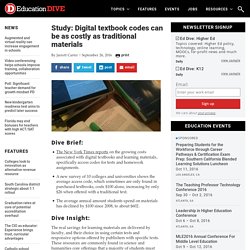
A new survey of 10 colleges and universities shows the average access code, which sometimes are only found in purchased textbooks, costs $100 alone, increasing by only $26 when offered with a traditional text. The average annual amount students spend on materials has declined by $100 since 2008, to about $602. What makes a successful online learner (July 2016) 5 charts that explain the future of education. Children need to learn social and emotional skills if they are to thrive in the workplace of the future, a World Economic Forum report has found.
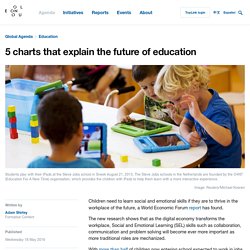
The new research shows that as the digital economy transforms the workplace, Social and Emotional Learning (SEL) skills such as collaboration, communication and problem solving will become ever more important as more traditional roles are mechanized. With more than half of children now entering school expected to work in jobs that don’t yet exist, adaptability is becoming a core skill. Social and Emotional Learning skills are those abilities that lie outside core literacies such as reading, writing and arithmetic. They allow creativity, problem solving and communication and have at their heart social interactions.
Of 16 skills identified in the report as important for the 21st century, 12 are SEL. Students require 16 skills for the 21st century. Study: Open access ed tech system may triple in next five years. Dive Brief: A survey of more than 500 faculty members reveals that open educational resources (OER) in higher ed could grow to become the primary digital learning resource in the next five years, tripling from 4% to 12%.
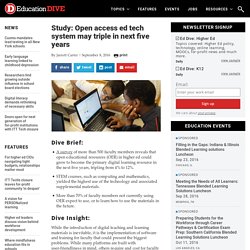
STEM courses, such as computing and mathematics, yielded the highest use of the technology and associated supplemental materials. Employee%20Skills%20Survey%20Leaflet. Opening up Education: A Support Framework for Higher Education Institutions. WEF GITR Full Report. 2015 nmc horizon report k12 EN. Adding some Tec Variety. Future Ready Learning. La buona scuola digitale. 01 marzo 2019 Avviso per partecipazione alla Settimana del PNSD e #FUTURAGENOVA Allegato Regolamento per la partecipazione al concorso #ilmioPNSD Allegato.

WEF Future of Jobs. Partial Credit: The 2015 Survey of Faculty Attitudes on Technology. Colleges and universities have spent hundreds of millions of dollars on technology they believe will improve student outcomes and simplify administrative tasks.
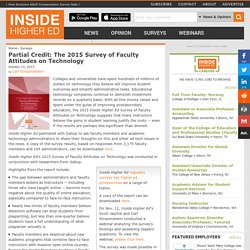
Educational technology companies continue to demolish investment records on a quarterly basis. With all this money raised and spent under the guise of improving postsecondary education, the 2015 Inside Higher Ed Survey of Faculty Attitudes on Technology suggests that many instructors believe the gains in student learning justify the costs -- even if the results are perhaps less significant than desired. Inside Higher Ed partnered with Gallup to ask faculty members and academic technology administrators to share their thoughts on this and other ed-tech issues in the news. A copy of the survey results, based on responses from 2,175 faculty members and 105 administrators, can be downloaded here.
Can Facebook boost MOOC retention? - eCampus News. A new study on MOOC course design reveals that students prefer Facebook’s collaboration and interaction features to those of built-in MOOC communication tools.
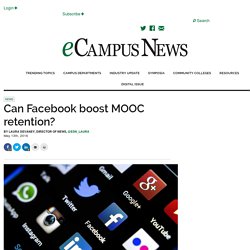
Social media tools might be the key to keeping students engaged in MOOCs and preventing course dropouts, according to new research on MOOC course design that was presented at the annual ACM conference on Learning at Scale on April 26. A study comparing students’ use of their MOOC course’s built-in message boards and forums to the same students’ use of course Facebook groupe revealed that students seemed more engaged in the Facebook groups. Students told researchers they preferred social media interaction to interacting with the MOOC communication tools.
Results of the study have implications for future MOOC course design, the researchers said in their paper, parts of which are available by registering for the Learning at Scale flipped conference online. (Next page: About the MOOC course design study) Digital devices' exam impact 'substantially negative' Dive Brief: A new study out of MIT shows students who use laptops, tablets or other digital devices in class perform at a significantly lower rate on exams than peers who are not permitted to use devices in class.
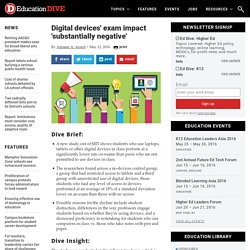
The researchers found across a no-devices control group, a group that had restricted access to tablets and a third group with unrestricted use of digital devices, those students who had any level of access to devices performed at an average of 18% of a standard deviation lower on an exam than those with no access. Openingthecurriculum2014. Only 1 in 5 Students Obtain All Learning Materials Legally. Research Only 1 in 5 Students Obtain All Learning Materials Legally A new study on student piracy makes a convincing case for open educational resources in higher education.
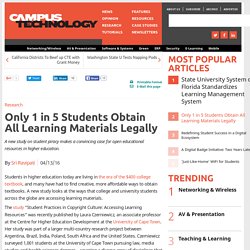
Students in higher education today are living in the era of the $400 college textbook, and many have had to find creative, more affordable ways to obtain textbooks. A new study looks at the ways that college and university students across the globe are accessing learning materials. The study “Student Practices in Copyright Culture: Accessing Learning Resources” was recently published by Laura Czerniewicz, an associate professor at the Centre for Higher Education Development at the University of Cape Town.
AMDI report press release final. Work in the Future Will Fall into These 4 Categories. From The New York Public Library Organizations are more boundary-less, agile, global, and transparent — and will be even more so in the future.
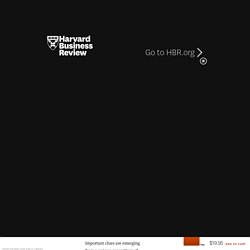
Work and workers (yes, humans) will always be essential to organizations, but organizations themselves will be more diverse, and work will be organized, structured, and done in new ways, increasingly through arrangements outside of regular full-time employment. How can leaders navigate this new digital work ecosystem? How should your organization plan for the changes ahead? Most adults claim to be lifelong learners, but training isn't primarily online. Dive Brief: Nearly three-quarters of adults consider themselves lifelong learners but they don’t, in such large numbers, report online learning to be the source of their continuing education.
New survey data from the Pew Research Center shows personal and professional learners cite community or workplace settings as the locations of their educational opportunities far more than online courses — with 30- to 35-percentage-point gaps between the in-person and online scenarios. As with other surveys, this latest data shows adults with higher educational attainment levels and higher incomes are more likely to engage in personal or professional learning, and white adults are more likely than black or Latino adults. Dive Insight: While the internet was supposed to democratize education with open access, barriers have remained in place. New Vision for Education: Fostering Social and Emotional Learning Through Technology. The New Vision for Education project examines the role that technology can potentially play to improve education for the future. In phase II, we investigated innovative ways to help students develop competencies* and character qualities** broadly defined as social emotional skills, which are critical components of 21st century skill framework but not a core focus in today’s curriculum.
Can technology effectively facilitate the development of competencies and character qualities, in addition to cognitive skills? If yes, what are the opportunities to capture to make it happen? What are the immediate, mid-term, and long-term barriers to remove? How can multistakeholders work together to create a roadmap for this vision? What makes students stick with a MOOC? By Joan Brasher | Feb. 26, 2016, 12:39 PM | Want more research news? Subscribe to our weekly newsletter » PISA.
TIMSS. PIRLS. The Progress in International Reading Literacy Study (PIRLS) is an international study of reading achievement in fourth graders. The international population for PIRLS consists of students in the grade that represents four years of schooling, provided that the mean age at the time of testing is at least 9.5 years. It is designed to measure children’s reading literacy achievement, to provide a baseline for future studies of trends in achievement, and to gather information about children’s home and school experiences in learning to read.
PIRLS study is conducted by the International Association for the Evaluation of Educational Achievement (IEA). Since 1995, 12 countries have raised their average mathematics achievement at the fourth grade level; eight have done so in science; and 10 have increased their reading achievement. National Literacy Strategy English. Monitor2013 mt en. LanguageProfile Country Report Malta EN. School Leaving in Malta June 2014. NCFHE Annual Report 2014 compressed. OneTabletPerChild PilotStudy Main results. Malta National Lifelong Learning Strategy 2020 Draft for Public Consultation. NCFHE 4th Referencing Report 2016. Digital Malta 2014 2020. Education Strategy Malta 2014 2024 ENG 19 02. A National Curriculum Framework for All 2012. EU2020 2015 malta en. Validation of non formal MOOCS lfna27660enn. Jrc101254 digcomp%202.0%20the%20digital%20competence%20framework%20for%20citizens.%20update%20phase%201. Promotig Effective Digial Age Learning EU jrc98209 r digcomporg final.
Report shows digital skills are required across all types of work, also for jobs outside the office. En manifesto 2014. E skills manifesto.
Rethinking Education 2012. Rethinking Education Country Analysis. Camilleri et al (2014) State of the Art Review of Quality issues re OER. EU DigitalAgenda MT. Camilleri - State of the Art Review of Quality Issues related to Open Educational Resources (OER) FINAL INTERNATIONAL e Skills report Aug 14. Horizon report eu en 2015. European Schoolnet 2015 Country Report Malta. MOOCs Are Still Rising, at Least in Numbers. When one of the first massive open online courses appeared at Stanford University, 160,000 students enrolled. It was 2011, and fewer than 10 MOOCs existed worldwide. It has been four years since then, and according to a new report, the cumulative number of MOOCs has reached nearly 4,000. Compiled earlier this month by Dhawal Shah, founder of the MOOC aggregator Class Central, the report summarizes data on MOOCs from the past four years.
And the data show that even as the MOOC hype has started to die down, interest hasn’t tapered off. The cumulative number of MOOCs didn’t break 100 until the end of 2012. “Introducing any kind of technology like this, it’s the novelty of the technology that people talk about initially,” said Richard A. Most of those people, the report says, are seeing value in similar kinds of courses: Introductory classes in statistics and computer science are among the most popular MOOCs of all time. The popularity of the top providers, Mr. Mr. Return to Top. Top 10 Education Systems in the World.
Every three years, the Programme of International Student Assessment (PISA) conducts an international assessment of the educational programs provided in countries across the world. eSkills EU MONITOR Final Report 2014. Duke handbook final 03252014. BusITCareerFinal(3) OpenCases catalogue of mini cases on open education in Europe jrc96524. Open licensing playbook final. NETP16. Mckinsey MGI Online talent A labor market that works Full report June 2015. OECD - Education at a Glance 2015. Online education in USA in 2015 report. UNESCO ICT Competence Teachers 2015. World Economic Forum - NewVisionforEducation Report2015.
Digital Skills for Tomorrow's World. The accelerating digitization of the US economy. DUP 758 ReimaginingHigherEducation. PreparingDigitalUniversity. Innovating Pedagogy 2015 (Open Univ) The Open University Innovating Pedagogy 2014 0. Study: Faculty members skeptical of digital course materials, unfamiliar with OER. Quality, cost, reputation -- in that order. Those are the top three factors that influence how faculty members pick which textbooks and course materials they assign, according to the results of a survey of faculty at two- and four-year institutions. Virtually every faculty member surveyed (97.1 percent) for “Going Digital,” a report being presented today at the Independent College Bookstore Association retail conference in Orlando, Fla., said their own assessment of the quality of a textbook is an important or a very important factor influencing their course material selection process, followed by the cost (86.3 percent) and a near tie between comments from colleagues (71.2 percent) and students or teaching assistants (71.1 percent).
Shifting tides: Global economic scenarios for 2015–25. At the National People’s Congress in Beijing in March 2015, China’s Premier Li Keqiang announced a growth target of 7 percent, acknowledging that “deep-seated problems in the country’s economy are becoming more obvious.” Three months later and thousands of miles away in Washington, the World Bank lowered its growth forecasts across the board and asked the US Federal Reserve Bank to delay any contemplated rate hikes.
The youngest college-goers still prefer on-campus degrees. UNESCO 2014 educ report. Examining Value Change in MOOCs in the Scope of Connectivism and Open Educational Resources Movement. September - 2015 Hayriye Tugba Ozturk Ankara University, Turkey Volume 16, Number 5 Abstract. What are Educause's top 10 IT issues and technologies of 2016? In its annual list of top IT issues, released Wednesday, Educause encourages college and university IT leaders to divest, reinvest, and differentiate in 2016.
A panel of experts — including IT and non-IT leaders, CIOs, and faculty members — curated the list, organizing the top 10 critical areas of focus into groups based on these three major challenges. Examining Value Change in MOOCs in the Scope of Connectivism and Open Educational Resources Movement. Partial Credit: The 2015 Survey of Faculty Attitudes on Technology. "It's not chalk and talk anymore": School approaches to developing students' digital literacy. 2015 nmc horizon report k12 EN. VISION Final Report. Education to Employment FINAL.
Connected Learning report. 2015 K-12 Edition. What is on the five-year horizon for K-12 schools worldwide? Learning with New Media. Failure, noun: “The fact of failing to effect one’s purpose” (Oxford English Dictionary, failure, n. 3a) How Would Today’s Smartest Teens Overhaul Education? We Asked Them. LEGAL FUTURES Report: artificial intelligence will cause "structural collapse" of law firms by 2030.